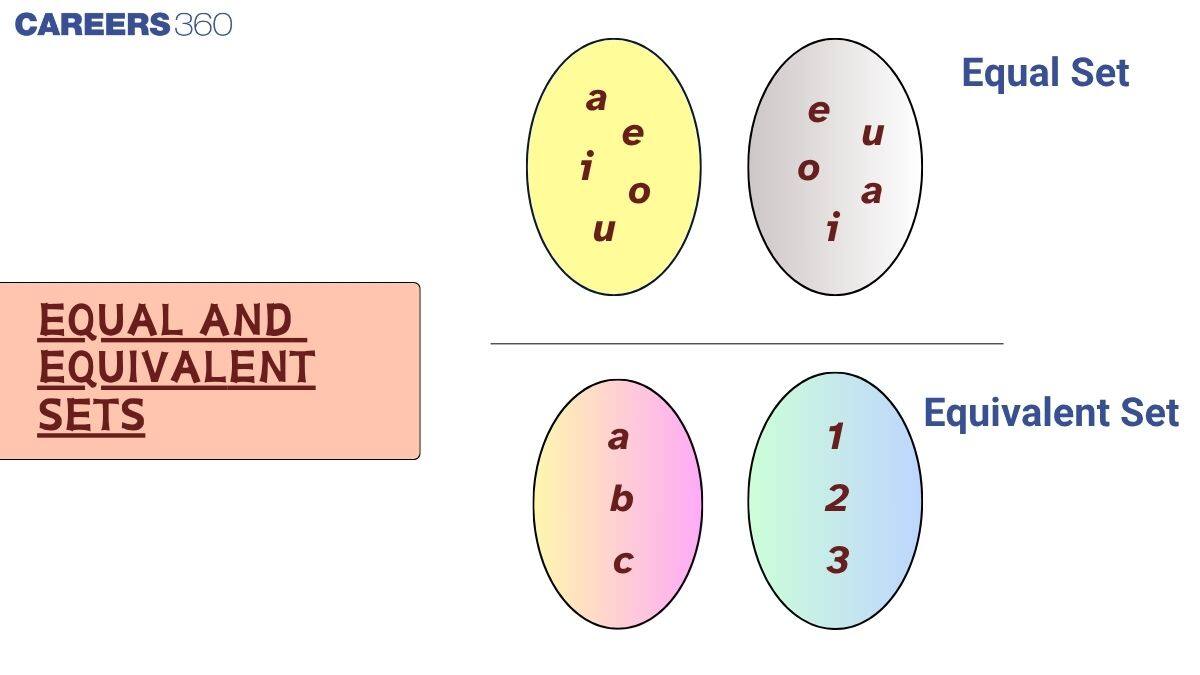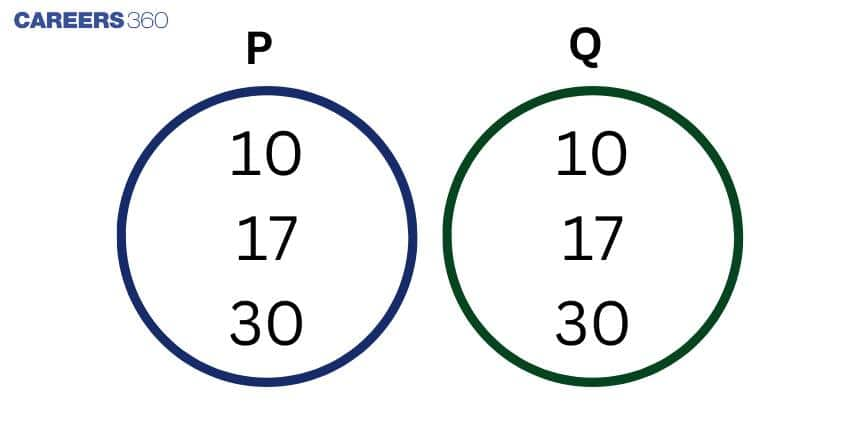Equal and Equivalent Sets
Understanding equal and equivalent sets is a fundamental part of set theory. These concepts help us compare sets based on their elements and the number of elements they contain. In simple terms, equal sets have exactly the same elements, while equivalent sets have the same number of elements, regardless of what those elements are. This article covers the definition of equal and equivalent sets, explains the difference between equal and equivalent sets, and provides examples of equal and equivalent sets to clarify each concept. You'll also find a worksheet on equal and equivalent sets with answers to reinforce learning through practice. Whether you're asking what is equal and equivalent sets in mathematics or looking for equal and equivalent sets examples, this resource offers everything you need in one place.
This Story also Contains
- Overview of Sets
- What are equal and equivalent sets?
- How do you check whether sets are equal or not?
- Properties of Equal and Equivalent Sets
- Solved Examples based on Equal and Equivalent Sets
- List of related topics to Equal and Equivalent Sets
- NCERT Useful Resources
- Practice Questions based on Equal and Equivalent sets

Overview of Sets
A set is a collection of distinct items grouped together. These items are called elements. For example, the set of even numbers less than 10 is written as $A = \{2, 4, 6, 8\}$. Sets are shown using curly braces $\{ \}$ and named with capital letters like $A$, $B$, or $C$. Elements shouldn’t repeat.
For example, $B = \{\text{apple}, \text{banana}, \text{mango}\}$ is a valid set of fruits. Sets are used to represent groups with common features.
What are equal and equivalent sets?
In set theory, it's common to compare two sets to check how similar they are. Sometimes, sets may look different but have something in common—like the same elements or the same number of elements. In the sections below, we’ll explore what makes two sets equal and what makes them equivalent, along with clear examples. You’ll understand how to identify and differentiate between equal and equivalent sets easily.
Equal Sets Definition
Two sets are called equal when they contain exactly the same elements, with no extra or missing items. The order of elements doesn't matter, but the content must be identical.
If $A = \{3, 2, 1, 4\}$ and $B = \{2, 3, 4, 1\}$, both sets have the same elements. So, we write $A = B$.
If even one element differs, the sets are not equal, and we write $A \neq B$.
Equal Sets Representation Using Venn Diagram
Equal sets can be visually represented using a Venn diagram to show that both sets have exactly the same elements. When two sets are equal, their Venn diagram overlaps completely, indicating no difference in elements.
For example, if $P = \{10, 17, 30\}$ and $Q = \{10, 17, 30\}$, then both sets contain the same elements, and we write $P = Q$. In the Venn diagram, sets $P$ and $Q$ would completely overlap, showing they are identical.

Equivalent Sets Definition
Two sets are called equivalent if they have the same number of elements, even if the elements themselves are different. What matters is the count, not the content.
If $A = \{H, T, P, V\}$ and $B = \{1, 2, 3, 4\}$, both sets have 4 elements, so we say $A$ and $B$ are equivalent sets.
We write this as $n(A) = n(B)$, meaning both sets have equal cardinality.
Equivalent Sets Representation Using Venn Diagram
Equivalent sets can be shown using a Venn diagram to highlight that two sets have the same number of elements, even if the elements are different. Unlike equal sets, their elements don’t need to match—only the count matters.
For example, if $P = \{3, 6, 9\}$ and $Q = \{a, b, c\}$, both sets have three elements. So, $P$ and $Q$ are equivalent, and this can be represented by showing two separate but equally sized sets in a Venn diagram.
How do you check whether sets are equal or not?
When comparing, two sets, one has to check whether ' $A$ ' and ' $B$ ' are composed of the same elements or not. For example, set $A$ was defined as the set of $\{2,3,4\}$ and set $B$ was also defined as the set of $\{4,3,2\}$ and thus set $A$ and set $B$ are equal sets. Comparing two sets requires us to consider how many elements each set contains to come up with the conclusion that the two are equivalent.
Properties of Equal and Equivalent Sets
Equal and equivalent sets follow certain rules that help us identify and compare them accurately. These properties make it easier to understand how sets relate to each other based on their elements or size. Below, we’ll look at the key properties of equal and equivalent sets with simple explanations.
Properties | Equal Sets | Equivalent Sets |
1 | The order of elements does not affect equality. | Sets are equivalent if they have the same number of elements. |
2 | Equal sets must contain exactly the same elements. | The elements can be different; only the count matters. |
3 | All elements in both sets are equal. | Elements may or may not be the same. |
4 | Their cardinality (number of elements) is always equal. | Cardinality is also equal. |
5 | Two sets are equal if they are subsets of each other: $A \subseteq B$ and $B \subseteq A$. | Equivalent sets are not required to be subsets of each other. |
6 | All equal sets are also equivalent. | Equivalent sets are not always equal. |
7 | Equality is denoted by $A = B$. | Equivalence is denoted by $A \sim B$ or $A \equiv B$. |
8 | The symbol used to denote equal sets is '=' | The symbol used to denote equivalent sets is ~ or ≡ |
Solved Examples based on Equal and Equivalent Sets
Understanding sets becomes easier with examples. Below are simple and clear examples of equal and equivalent sets to help you quickly grasp the difference between them based on their elements and count.
Example 1: Which of the following are equal sets?
1) $A=\{1,2,3,4\}$ and $B=$ collection of natural numbers less than 6
2) $A=\{$ prime numbers less than 6$\}$ and $B=\{$ prime factors of 30$\}$
3) $A=\{0\}$ and $B=\{x: x>15$ and $x<5\}$
4) $\mathrm{A}=\{5\}$ and $\mathrm{B}=\left\{\mathrm{x}: x^2=25\right\}$
Solution
In option (1), $A=\{1,2,3,4\}$ but $B=\{1,2,3,4,5\}$, hence not equal.
In option (2), $A=\{2,3,5\}$ but $B=\{2,3,5\}$, hence equal.
In option (3), $A=\{0\}$ but $B=$ Null set, hence not equal.
In option (4), $A = {5}$ but $B = {-5, 5}$, hence not equal.
Hence, the answer is option (2).
Example 2: Which of the following is NOT true?
1) Equivalent sets can be equal.
2) Equal sets are equivalent.
3) Equivalent sets are equal.
4) None of these
Solution
In this Question,
Equivalent sets may or may not be equal sets, but equal sets always have the same number of elements and hence equal sets are always equivalent.
Hence, the answer is option 3.
Example 3: Which of the following are equal sets?
1) $A_1$ is a set of letters of ALLOY and $B_1$ is a set of letters of LOYAL.
2) $A_2=\left\{n: n \in Z\right.$ and $\left.n^2 \leq 4\right\}$ and $B_2=\left\{n: n^2-3 n+2=0\right\}$
3) $A_3=\left\{x: x^2=9\right\}$ and $B_3=\{3\}$
4) $A_4=\{x: x$ is a vowel $\}$ and $B_4=\{\mathrm{a}, \mathrm{e}, \mathrm{i}, \mathrm{u}\}$
Solution
(1) $A_1=\{\mathrm{A}, \mathrm{L}, \mathrm{O}, \mathrm{Y}\}$, and $B_1=\{\mathrm{L}, \mathrm{O}, \mathrm{Y}, \mathrm{A}\}$, these are equal sets since they have exactly the same elements.
(2) $A_2=\{-2,-1,0,1,2\}, B_2=\{1,2\}$, so unequal.
(3) $A_3=\{3,-3\}, B_3=\{3\}$, so unequal.
(4) $A_4=\{a, e, i, o, u\}, B_4=\{a, e, i, u\}$, so unequal.
Hence, the answer is option (1).
Example 4: Which of the following are NOT equivalent sets?
1) $P=\{A, B, C, D, E\}$ and $Q=\{$ Jan,Feb,Mar,April,May $\}$
2) $P=\{x: x$ is a prime number on dice $\}$ and $Q=\{x: x$ is an even number on dice $\}$
3) $P=\left\{x: x \in R\right.$ and $\left.x^2-5 x+6=0\right\}$ and $Q=\left\{x: x \in R\right.$ and $\left.x^2-4 x+5=0\right\}$
4) $A=\{x: x$ is a vowel $\}$ and $B=\{x: x$ is a natural number less than 6$\}$
Solution
In (A), both sets have $5$ elements, hence they are equivalent.
In (B), $P=\{2,3,5\}$ and $Q=\{2,4,6\}$, hence equivalent.
In (C), $P$ has 2 elements as there are 2 roots of $x^2-5 x+6=0$ (as discriminant $>0$ ), but $x^2-4 x+5=0$ has no real roots (as discriminant $<0$ ), so $Q$ is empty, hence they are not equivalent.
In (D), both sets have $5$ elements, hence they are equivalent.
Hence, the answer is option 3.
List of related topics to Equal and Equivalent Sets
To fully grasp the concept of Equal and Equivalent Sets, it's important to explore other closely linked set theory topics. Concepts like Empty Set, Subsets, Finite and Infinite Sets, Singleton Set, Power Set, and Universal Set provide the foundational understanding necessary to distinguish between equality and equivalence of sets in various mathematical contexts.
NCERT Useful Resources
Find all the essential NCERT study materials for the chapter Sets in one place. This includes detailed notes, solved exemplar problems, and NCERT solutions covering important topics like types of sets, empty sets, set operations, Venn diagrams, and more—perfect for quick revision and concept clarity.
NCERT Maths Class 11 Chapter 1 Sets Notes
Practice Questions based on Equal and Equivalent sets
Test your understanding with these quick MCQ-based practice questions on equal and equivalent sets. These are designed to help you identify key concepts and learn through simple, objective-type problems.
Equal And Equivalent Sets - Practice Question MCQ
To practice questions on the next topics covering subsets, finite sets, power sets, union and intersection of sets, check below:
Frequently Asked Questions (FAQs)
Equal sets can be defined as those sets that contain the same or equal elements as the other and they suggest that there is a one-to-one relationship in which each member of one of the sets is also a member of the other without duplication or omission of any element. Two sets having the same number of elements are called equivalent sets.
Example of equal and equivalent sets are as follows-
Equal set: Let $A$ be set of natural numbers and $B$ be set of whole numbers greater than $0$. $A = \{1,2,3,4,5,6....\}$ and $B = \{1,2,3,4,5,6,....\}$ have the same exact elements. So, the sets $A$ and $B$ are equal sets.
Equivalent set: Let $A$ be natural numbers less than $6$ and $B$ be whole numbers less than $5$. The cardinality of both sets $A$ and $B$ are equal. So, the sets $A$ and $B$ are equal.
Comparable set means that each element of one set can be paired with exactly one element of other set, and vice versa.
When comparing, two sets, one has to check whether ' $A$ ' and ' $B$ ' are composed of the same elements or not. For example, set $A$ was defined as the set of $\{2,3,4\}$ and set $B$ was also defined as the set of $\{4,3,2\}$ and thus set $A$ and set $B$ are equal sets. Comparing two sets requires us to consider how many elements each set contains to come up with the conclusion that the two are equivalent.
The difference between equal and equivalent sets can be stated as - sets are equal if all elements are equal in two or more sets whereas if the number of elements in two or more sets is the same, they are equivalent sets.